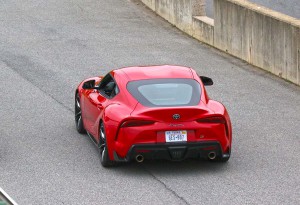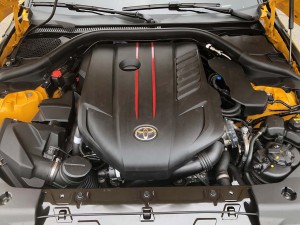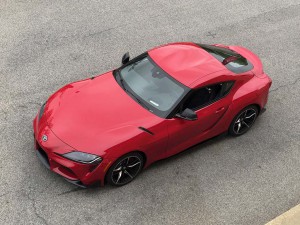
Tetsuya Tada, chief engineer for the 2020 Toyota GR Supra flashes a thumbs-up during the sports car's first media drive.
(This story has been corrected to reflect the proper spelling of Supra Chief Engineer Tetsuya Tada.)
The call came as a surprise. The chief engineer overseeing Toyota’s joint venture with Subaru that resulted in the 86 sports car, Tetsuya Tada was attending a media event in Barcelona when he was asked to jump on a flight for Munich seven years ago this month.
“Don’t tell anybody,” his boss said, and didn’t give Tada himself much to go on, beyond advising him there would be a car waiting at the airport. Once he arrived, the Toyota veteran learned he was being driven over to BMW headquarters, putting into motion one of the most unusual alliances in the history of either manufacturer.
Almost seven years to the day after that first meeting, Tada is sharing a dinner in suburban Washington, D.C. and, for the first time, revealing the back story of what eventually became the 2020 Toyota GR Supra – as well as the new BMW Z4.
(Click Here for our review of the 2020 Toyota GR Supra.)
At that point, it had already been 14 years since the Japanese automaker had pulled the third-generation Supra from production and it was a sticking point for Toyota’s CEO Akio Toyoda. The grandson of the company founder and a serious performance driver, Toyoda was desperate to change the carmaker’s plain-vanilla image, and was fond of working the word, “passion” into any discussion about what sort of products Toyota should be building.
The problem was that there wasn’t a reasonable business case for Toyota bringing Supra back into production – at least not on its own. But Tada had shown there was an alternative solution, steering the joint venture with Subaru that resulted in not only that company’s BRZ model but the Toyota 86. Could the Japanese automaker come up with a similar plan with BMW?
Initially, it seemed like the answer was going to be “no.” The initial meetings seemed to find the two companies focusing on very different ideas. “The initial reception was lukewarm,” Tada explained over dinner last week. The team led by Herbert Diess, then BMW’s head of engineering, seemed more interested in coming up with a volume model than a sports car, and one that would utilize an existing BMW platform.
Suddenly, there was a shake-up at BMW’s distinctively styled Munich corporate headquarters. Diess was gone – headed for Volkswagen where he is now the CEO. “All of a sudden, the conversation shifted,” and the new BMW team, said Tada, seemed much more open to the project.
(Toyota set to unleash flood of 19 new products. Click Here for the story.)
While both companies had open minds about what they would develop, both knew that they needed to find a way to hold down costs – the biggest obstacle to them developing a new Z4 and Supra independently. But Tada said a critical moment came at a meeting in Munich, when his BMW counterpart stressed “You can’t do this type of car based on cost savings.” It had to be the best car possible for each company.
As things started falling into place, it became clear that an entirely new platform would be needed, and one that would adopt the “Golden Ration,” or classic sports car proportions: a short wheelbase, a wide track and a low center of gravity. But where Toyota wanted a Supra coupe, BMW was looking at a replacement for the Z4 roadster. The solution was to view the project as creating the equivalent of the hardtop Porsche Cayman and the convertible Porsche Boxster.
Perhaps the biggest surprise of the story turns out to be the fact that the BMW and Toyota teams “completely separated” in 2014, soon after the basic decisions on the common platform were reached, noted Tada. From that point on, they worked independently, with only occasional communications.
Toda himself claims he’s spent less than an hour in the new Z4 and isn’t sure his BMW counterpart has yet driven the new Supra. That said, Tada described the German roadster as “a fabulous car. If I were going to buy a convertible today it would be the Z4.”
One could argue that there’s still a lot of European DNA in the new Supra, veteran Belgian race driver Herwig Deanens overseeing the development of the Toyota sports car’s dynamics.
The Supra chief engineer goes to great length, during a lengthy dinner conversation, to stress that the Toyota sports car isn’t just a Z4 in another skin, but he does acknowledge that there are some shared elements. That includes a modified version of the suspension used for the latest BMW 3-Series. That approach not only helped hold down costs but also means it will be easier to get aftermarket components that can be used on both Z4 and Supra.
Another key decision – and one generating significant debate – was the decision to share BMW’s 3.0-liter inline-six engine, rather than one of Toyota’s off-the-shelf powertrains. The simple explanation is “balance,” says Tada. That is something that no other type of engine can match, he asserts, and Toyota simply didn’t have an inline-six of its own. That’s not the only controversy, however. Critics question why Supra’s package makes just 335 horsepower and 365 pound-feet of torque, compared to Z4’s 382 hp and 369 lb-ft. Again, says Tada, “it’s all about balance. More power isn’t necessarily better.”
(Click Here to check out the new Toyota Corolla Hybrid.)
Far less controversial is the fact that the Z4 and Supra boast distinctively different styling. That’s a lesson Tada learned from the joint venture with Subaru, taking heat for the fact that the 86 and BR-Z are all but identical, whether talking about ride or design.
It’s clear that the partnership with BMW was a challenging one. It took six years for the Bavarian automaker to get its Z4 into production and another year before Toyota was ready with the Supra.
It helped, Tada acknowledges, that the project had the strong support of Toyota CEO Toyoda. “A normal businessman would have told me to scuttle the program.”
Whether the unusual project was justified is yet uncertain. Clearly, the results of the joint venture are coming at a relatively inopportune moment, sedans, coupes and sports cars losing ground rapidly to SUVs, CUVs and pickups. But initial reaction to both Z4 and, now, the 2020 Toyota GR Supra has been overwhelmingly positive. Now, the Japanese automaker will have to wait to see if that translates into sales.



